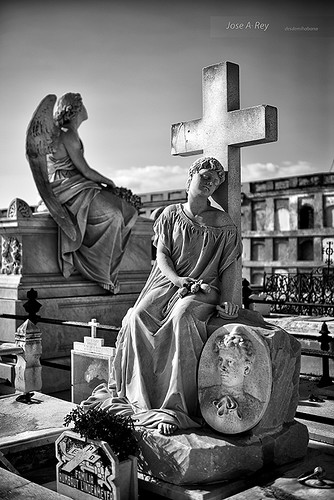En 1836 esta porción baja de tierra no pertenecía a la villa que solo llegaba por el oeste hasta la avenida de Arango. Se decide por las autoridades de entonces trasladar el cementerio que se encontraba en la manzana Santa Elena-Velazco-Santa Cruz-Casales para el sitio donde hoy se halla como reliquia histórica y monumento nacional en vías de desaparecer, a pesar de los esfuerzos realizados, por falta de presupuesto para su restauración.
El motivo del traslado era simple: alejar de los pobladores posibles contagio por cadáveres de fallecidos del cólera u otras enfermedades infectocontagiosas. Parece haber influido en esta decisión la campaña sanitaria del Dr. Tomás Romay Chacón y la edificación del Cementerio Espada en La Habana, en 1805, del cual se tomaron algunas características constructivas y de ubicación geográfica. Observemos que en Cienfuegos los vientos soplan regularmente del sur-sudeste por el día, y del norte-nordeste por la noche, y así tanto la brisa marina diurna como la virazón nocturna llevarían las posibles impurezas contenidas en el aire hacia el mar, alejándolas del núcleo poblacional. Ubicación muy bien pensada que se hizo realidad en 1839.
In 1836 this lower portion of land belonging to the village not only came as far west Arango Avenue. It was decided by the authorities then moved the cemetery was in Santa Elena-Velazco apple-Santa Cruz-Casals for the site where today is as a historical relic and national monument in the process of disappearing, despite the efforts made, for lack of funds for restoration.
The reason for the move was simple: the people away from possible contagion dead bodies of cholera or other infectious diseases. Seems to have influenced this decision the health campaign of Dr. Tomas Romay Chacon and the edifying of the Espada Cemetery in Havana in 1805, which took some construction characteristics and geographic location. Note that in Cienfuegos winds blow regularly from the south-southeast during the day, and north-northeast at night, and so both the daytime sea breeze as night virazón lead the impurities from the air to the sea, moving away from population center. Location very well thought that came true in 1839.
31 may 2013
Cementerio La Reina, Cienfuegos
Suscribirse a:
Enviar comentarios (Atom)


No hay comentarios:
Publicar un comentario
Comentarios